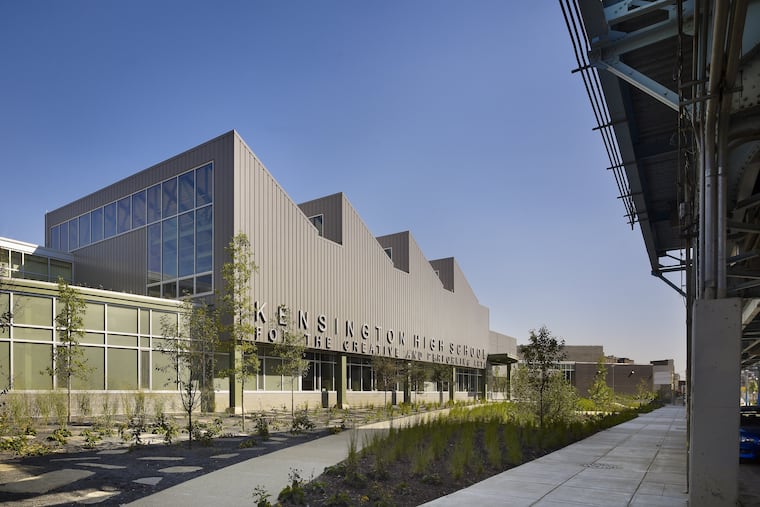Stressed by too much screen time, these Philly high school students staged a protest
“I barely eat, I’m sleeping all the time. This is not normal — you just can’t be on school online every day from 8 to 3. It’s too much,” student Leilani Ferrara said.

Fed up with what they say is too much screen time, some students from one Philadelphia high school refused to log on for school Monday, staging a protest they hope will draw attention to the plight of pandemic-stressed teenagers across the city and beyond.
Instead of attending virtual school from 8 a.m. to 3 p.m., dozens of students at Kensington High School for the Creative and Performing Arts declined to participate in classes.
Leilani Ferrara and her classmates don’t want to shirk work, the KCAPA sophomore said. In fact, the logoff was designed to catch up on missed or incomplete assignments, and organize around the fact that the current school schedule is unworkable, said Ferrara, 15, typically a strong student whose grades are now slipping.
“We are all depressed, we are all breaking down every day,” Ferrara said. “I barely eat, I’m sleeping all the time. This is not normal — you just can’t be on school online every day from 8 to 3. It’s too much.”
» READ MORE: Superintendent Hite’s grades slip in latest school board evaluation
Philadelphia School District students have not seen the inside of their classrooms since March when schools closed because of COVID-19. With the virus spiking, the district has no immediate plans to return children to school buildings.
Social studies teacher Ismael Jimenez has seen students grow increasingly stressed, sad, and unable to complete assignments, he said. They worry about too much work, not enough time to complete it, and a lack of one-on-one time with teachers — the kind of support they could get when classes were occurring in person.
“People are just slipping through the cracks,” Jimenez said.
KCAPA attendance has been declining. Last week, it was under 50%, Jimenez said. On Monday, nearly three-quarters of the 500 students were absent, he said.
To be counted as present for the day, students need only log in to one class.
» READ MORE: Free internet access available for some now struggling to afford it, city says
A group of student activists devised an alternative schedule with a mix of live and asynchronous classes, but it was rejected, they and Jimenez said.
There is no master district schedule. Individual schools have latitude to structure their days as administrators see fit. Some high schools have opted to start direct instruction later in the morning. Others give entire days to asynchronous learning, a model the KCAPA students say would help them.
KCAPA students are expected to be in classes for seven hours, with 10 minutes between classes and a lunch break. The students have taken their concerns to Principal Patricia McDermott-Fair, who has not made meaningful changes to the schedule, they said.
District leaders did not make McDermott-Fair available for comment. In a statement, Malika Savoy-Brooks, the district’s chief of academic supports, said she understood remote learning is challenging for some.
“In no way, do we expect students or staff to be engaged in on-screen activities for extended periods of time and we will continue to work with students, staff, and school communities to see how we can best support them while we remain engaged in digital learning,” Savoy-Brooks said. “We encourage anyone who has concerns about this matter to work with their school leaders with the ultimate goal of creating an environment where student progress is the ultimate priority.”
Students say they’re overwhelmed by hours of work followed by homework, beset by life responsibilities on top of schoolwork that’s complicated by a lack of in-person access to friends and teachers.
When the school day is over, junior Claribel Santos-Roman has to rush to work at a supermarket. When she comes home, she has to decide: sleep or schoolwork? When classes were in person, it was easier to understand lessons.
“I barely made it through last quarter,” Santos-Roman said. “I have mostly Cs or Ds or Fs because things are so hard. Last year, I was mostly an A student.”
Jayden Morales and his friends feel like different people now, Morales said.
“When school is over, I don’t want to leave my room,” said Morales, a sophomore. “I’m drained, mentally and physically.”
Junior Kayla Reynolds, 18, wants to finish high school. But now she’s getting mostly Ds and Fs.
“I’m not a good learner when it comes to virtual — I’m not slow, I just need face-to-face learning,” she said. “Some of us are thinking about dropping out of school.”